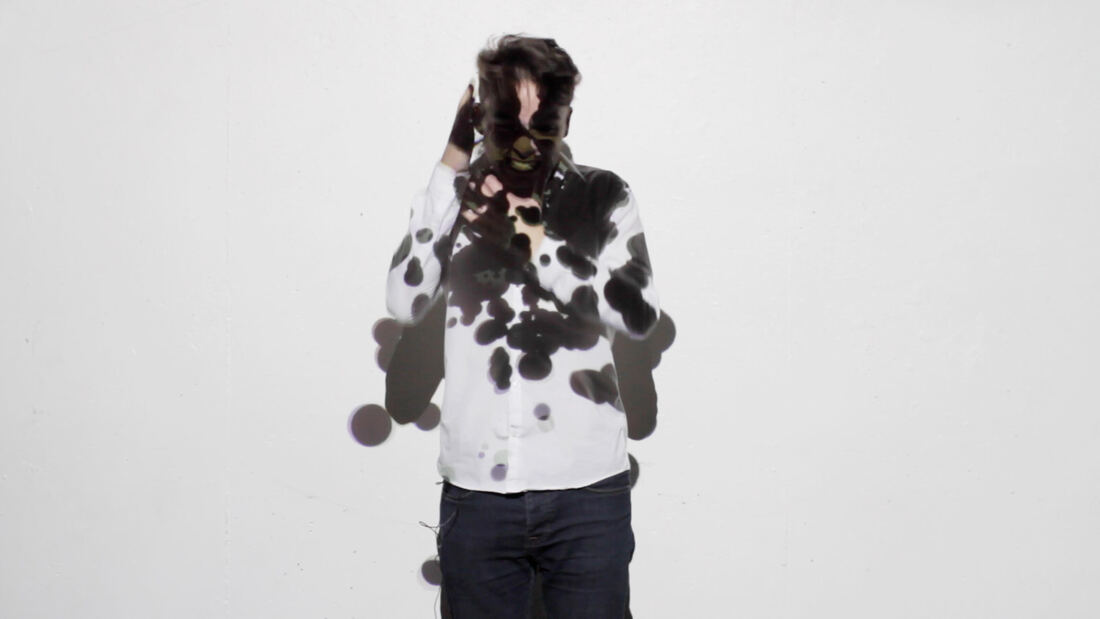Shadowpox: The Antibody Politic
Artistic Collaborators: Alison Humphrey, Caitlin Fisher, Steven J. Hoffman and LaLaine Ulit-Destajo
Full credits for Shadowpox
Motion-tracked interactive projections, aluminum frame, fabric, photographic prints, 2017.
Full credits for Shadowpox
Motion-tracked interactive projections, aluminum frame, fabric, photographic prints, 2017.
“...imagine the action of a vaccine not just in terms of how it affects a single body, but also in terms of how it affects the collective body of a community...” The Shadowpox storyworld imagines the emergence of a vaccine-preventable disease composed of viral shadows. Part fact, part science fantasy, the mixed-reality installation Shadowpox: The Antibody Politic conceived by Alison Humphrey combines real-world statistical data with motion-tracking digital effects coded in openFrameworks by Lalaine Ulit-Destajo. The game makes visible what is usually invisible to us: how our immunization decisions affect not just our personal health, but the health of other people in our community… and vice versa.
Underlying the game is a population-level statistical model created by Steven J. Hoffman and Susan Rogers Van Katwyk. As you fight the disease by pushing pox off your body, the virus may come in contact with one of the 99 other people around you. Their odds of becoming infected, and possibly dying, depend on your choice of country at the beginning of the game, through a calculation that blends that country’s vaccination rate with a more complex “severity score” based on the country’s levels of health expenditure, wealth and education. At the end of the game, abstract statistics transform into human stories in your “Infection Collection” or “Protection Collection”: a series of virtual trading cards, each depicting a person whose life your vaccination decision has affected, for better or worse. You can catch all 99 Poxémon cards, written by Caitlin Fisher, at shadowpox.org/ZZZ. In April 2020, the team adapted the game to an online version encouraging physical distancing to “flatten the curve” in the early, pre-vaccine phase of the COVID-19 pandemic. To play Shadowpox: #StayHome Edition, please visit shadowpox.org/game. These games are part of a larger project, a “citizen science fiction” storyworld co-created with young people on three continents, which forms Alison Humphrey’s doctoral research in media arts at York University. The first Shadowpox laboratory in 2016 developed the storyworld and visual effects at the UK’s Royal Academy of Dramatic Art. A 2018 collaboration with Debajehmujig Storytellers on Manitoulin Island workshopped the six-scene story structure Shadowpox: The Cytokine Storm, which was further refined in 2019 with the Desmond Tutu HIV Foundation Youth Centre in South Africa. In the spring of 2021, this story structure formed the core of a “courseplay” taught at York University. In Digital Culture: Science & Fiction undergraduates imagined acquired immunity through a superhero metaphor, creating their own characters as volunteers in a vaccine trial in the depths of a shadowpox pandemic, who must grapple with issues of informed consent, misinformation, hesitancy, denialism, and trust. Community immunity (when enough of a population has been immunized to prevent the spread of a contagious disease) is achieved not by a single hero, but by the dragon-slaying courage of hundreds of thousands. The Shadowpox project’s participatory storytelling structure and mixed reality visual effects enable its participants to generate new insights into one of the thorniest political dilemmas of public health: voluntary participation in the collective good. For more information, please visit www.shadowpox.org. |
Rethinking “Shadowpox” in the Era of Covid-19
Shadowpox: The Antibody Politic opens with the choice to “Get the Vaccine” or “Risk the Virus.” One of the creative challenges the team didn’t feel we cracked in 2017 was how to visualize the gameplay effectively if you choose the vaccine. You gather a “Protection Collection” of the neighbours you didn’t infect that at first glance looks almost identical to the “Infection Collection” you rack up if you choose to risk the virus. It’s a conundrum: How do you show things not happening? Early in the COVID-19 pandemic, we created an online Shadowpox: #StayHome Edition that gave us the chance to revisit that question. Instead of the previous choices, Sean Sollé suggested the game start with two buttons: “Distancing” and “No Distancing.” In the latter world, all 99 of your neighbours are making their own decisions not to physically distance, and if your character leaves home and passes the virus to one of them, your infection score goes up not just by one, but by as many other neighbours they pass it along to in turn. If, on the other hand, you choose to make your character #StayHome, nothing will happen, and you will earn the winning score of zero. There’s another choice at the start of the 2017 game that takes on even more powerful resonance in 2021. You choose which of 193 countries your character lives in, and the game’s algorithm draws on real-world statistics for that country to determine how susceptible your neighbours are to infection. But in today’s COVID-19 global body politic, while wealthy nations like Canada focus on convincing a shrinking minority of our citizens to Get the Vaccine from the lion’s share of doses we’ve bought up, the majority of people in the majority of nations still have to Risk the Virus whether they choose to or not. So perhaps the conundrum we should be turning to now is: Who is my neighbour? — Alison Humphrey, August 2021 |












